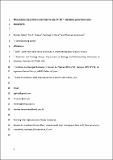Por favor, use este identificador para citar o enlazar a este item:
http://hdl.handle.net/10261/48817COMPARTIR / EXPORTAR:
 SHARE SHARE
 CORE
BASE CORE
BASE
|
|
| Visualizar otros formatos: MARC | Dublin Core | RDF | ORE | MODS | METS | DIDL | DATACITE | |

| Título: | Measuring selection coefficients below 10(-3): method, questions, and prospects |
Autor: | Gallet, Romain; Cooper, Tim F.; Elena, Santiago F. CSIC ORCID ; Lenormand, Thomas | Palabras clave: | Single-nucleotide substitutions Alcohol-dehydrogenase Polymorphism Term experimental evolution |
Fecha de publicación: | ene-2012 | Editor: | Genetics Society of America | Citación: | Genetics 190/1:176-186 (2012) | Resumen: | Measuring fitness with precision is a key issue in evolutionary biology, particularly in studying mutations of small effects. It is usually thought that sampling error and drift prevent precise measurement of very small fitness effects. We circumvented these limits by using a new combined approach to measuring and analyzing fitness. We estimated the mutational fitness effect (MFE) of three independent mini-Tn10 transposon insertion mutations by conducting competition experiments in large populations of Escherichia coli under controlled laboratory conditions. Using flow cytometry to assess genotype frequencies from very large samples alleviated the problem of sampling error, while the effect of drift was controlled by using large populations and massive replication of fitness measures. Furthermore, with a set of four competition experiments between ancestral and mutant genotypes, we were able to decompose fitness measures into four estimated parameters that account for fitness effects of our fluorescent marker (α), the mutation (β), epistasis between the mutation and the marker (γ), and departure from transitivity (τ). Our method allowed us to estimate mean selection coefficients to a precision of 2 × 10−4. We also found small, but significant, epistatic interactions between the allelic effects of mutations and markers and confirmed that fitness effects were transitive in most cases. Unexpectedly, we also detected variation in measures of s that were significantly bigger than expected due to drift alone, indicating the existence of cryptic variation, even in fully controlled experiments. Overall our results indicate that selection coefficients are best understood as being distributed, representing a limit on the precision with which selection can be measured, even under controlled laboratory conditions. | URI: | http://hdl.handle.net/10261/48817 | DOI: | 10.1534/genetics.111.133454 | E-ISSN: | 0016-6731 |
| Aparece en las colecciones: | (IBMCP) Artículos |
Ficheros en este ítem:
| Fichero | Descripción | Tamaño | Formato | |
|---|---|---|---|---|
| Genetics_190_175_2012-1.pdf | 3,23 MB | Adobe PDF |  Visualizar/Abrir |
CORE Recommender
PubMed Central
Citations
38
checked on 05-may-2024
SCOPUSTM
Citations
54
checked on 03-may-2024
WEB OF SCIENCETM
Citations
53
checked on 22-feb-2024
Page view(s)
317
checked on 07-may-2024
Download(s)
239
checked on 07-may-2024
Google ScholarTM
Check
Altmetric
Altmetric
Artículos relacionados:
NOTA: Los ítems de Digital.CSIC están protegidos por copyright, con todos los derechos reservados, a menos que se indique lo contrario.
